
Three olive blossoms in the bowl of a tea spoon for proportion. (The spoon was stainless, the darkening is my shadow.)

Three olive blossoms in the bowl of a tea spoon for proportion. (The spoon was stainless, the darkening is my shadow.)

It’s been fully five years since I posted here, and I’m not sure how to pick up the thread so I’m just posting some photos from our 89 days in Greece this year. In the intervening five years, we celebrated the 15th anniversary of our move-in; the date was October 24 last year, and we were here to pop a cork. (On October 24, 2007, we slept on a mattress on the floor, and were awakened the next morning by church bells so loud and jarring that we thought it was a tsunami or earthquake warning.) We missed an entire year due to COVID. And we witnessed the continuing commercialization of Sykia. But that’s for another post on another day. Probably another year.

A boardwalk was added to part of the beach a couple of years ago. In spring, wildflowers adorn the beach.

A two-masted sailboat moored in our bay overnight. Nice choice.

Artsy shot of wild capers growing on the beach. Old timers still collect and brine them. But not these old timers.

Sykia beach in spring.

Sykia beach in summer. Can you guess which one I prefer?

We were fortunate enough to visit Crete this time. Our last visit was in 1972. This is part of the Venetian harbor in Heraklion, the major city. The tunnels in the center are shipsheds built by the Venetians between the 15th and the 17 centuries. Originally, 19 of these sheds lined the waterfront.

The Venetian harbor in Heraklion has a great, brooding fortress along the seawall to protect the entrance. This is Rocca a Mare fortress, built in the 16th century.

It’s a nice fort to visit, with several displays conveying the reality of life inside. Here is a store of amphorae, likely used for oil and wine.

The star of the show in Heraklion is the nearby ruin of the palace of Knossos. Some details such as this have been imaginatively restored to give an impression of the grandeur that once awed the subjects of the kingdom. By legend, the Minotaur, a beast with the head of a bull and body of man, was kept in an elaborate labyrinth under this palace. The palace was constructed circa 1600 BC, making it more than 1200 years older than the classical-era Parthenon of Athens.
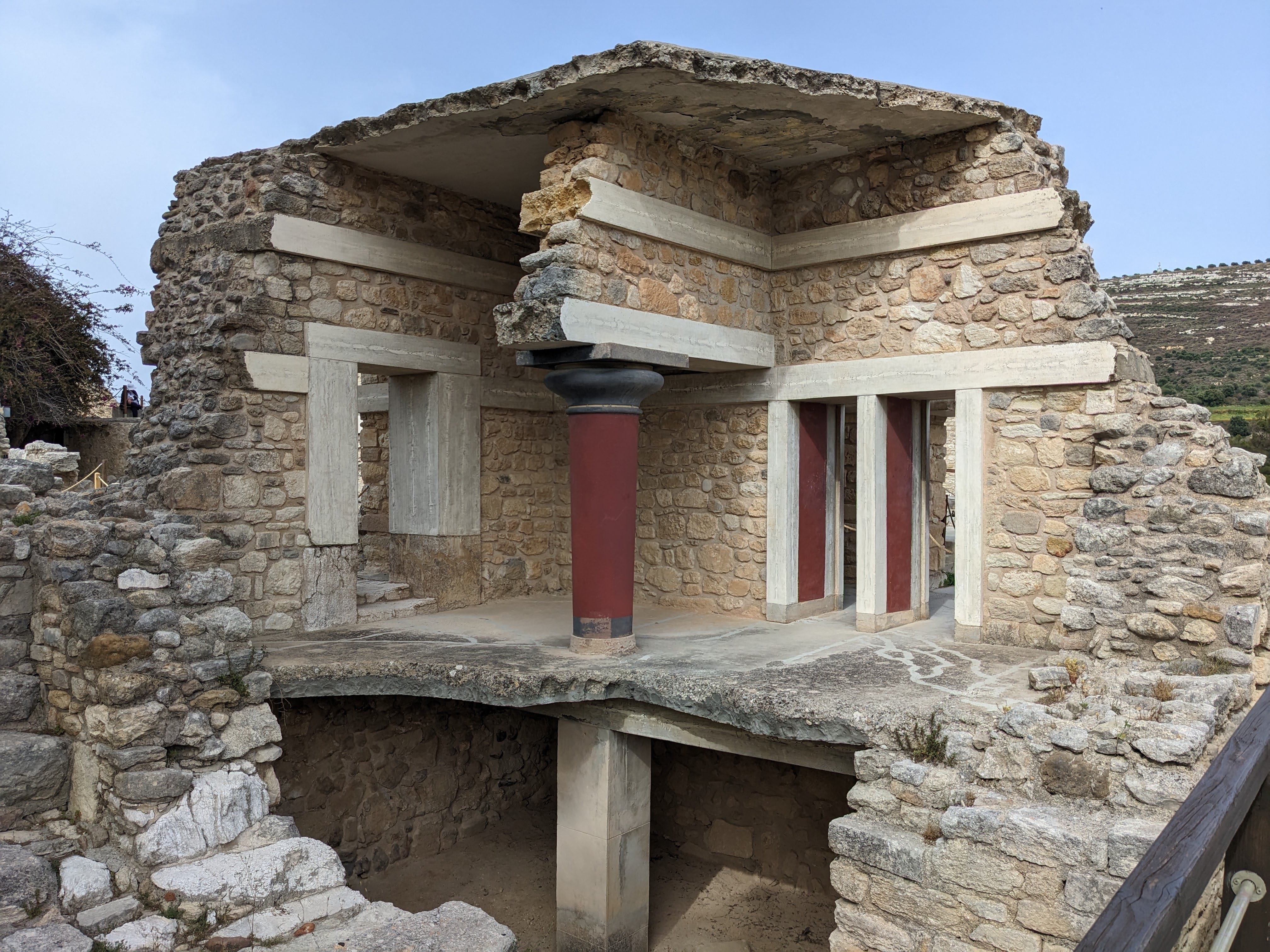
The palace is estimated to have covered three acres.

The throne room at Knossos. Minos was the legendary king of Knossos, and gives his name to the Minoan civilization.

Heraklion has a fine, extensive archeology museum that displays objects found during the excavation of Knossos, including this bull’s head, and the dolphin fresco below.
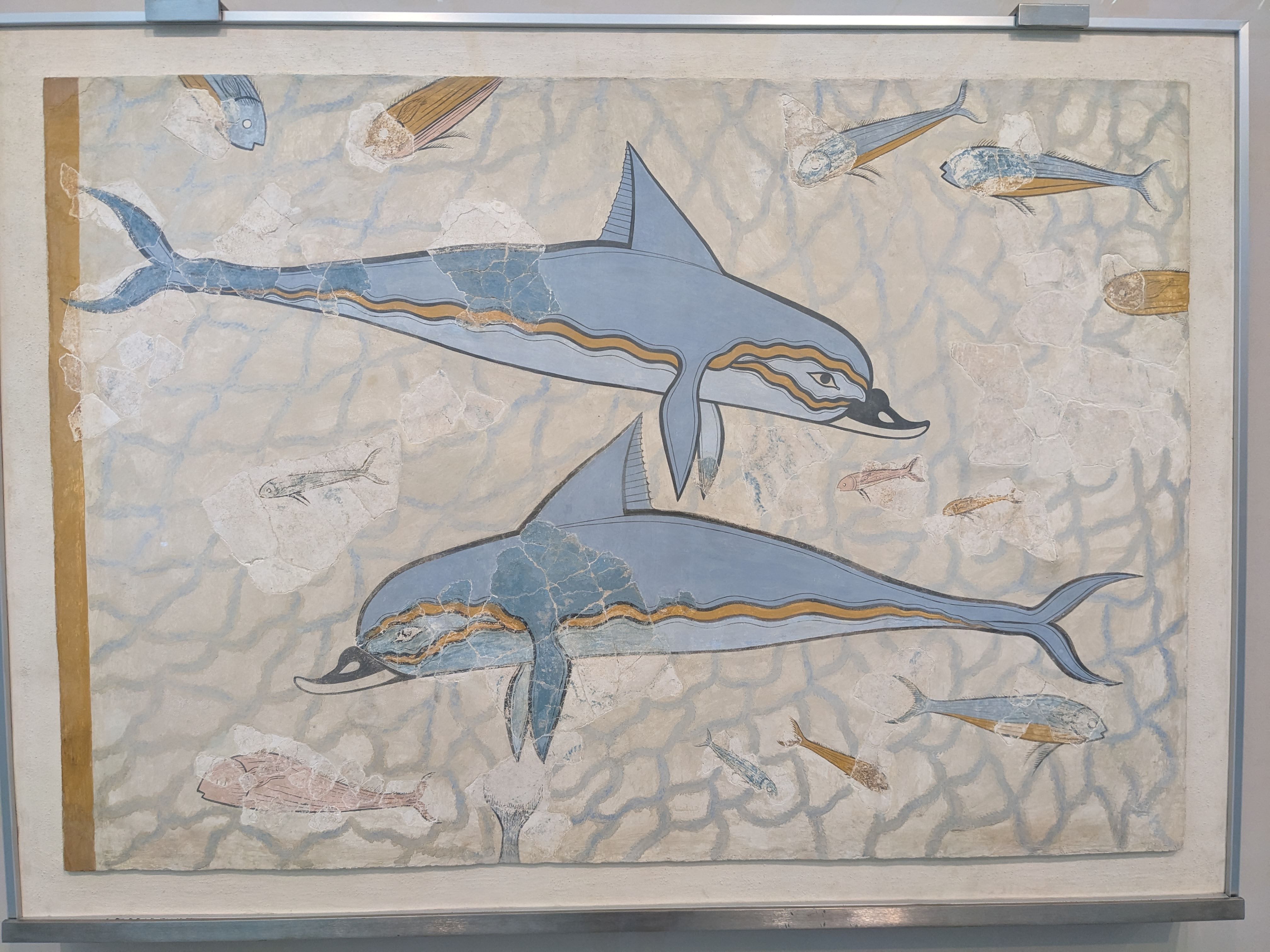

Three murals in Heraklion.



Heraklion city hall.

Leaving Heraklion, we detoured to see Matala beach on the south shore. This very fine beach is where in the ’60s an international community of young people (most famously perhaps, Joni Mitchell) took up residence in cliff-face caves on the right (out of sight here). The caves are thought to have been dug by Romans or early Christians for use as tombs.
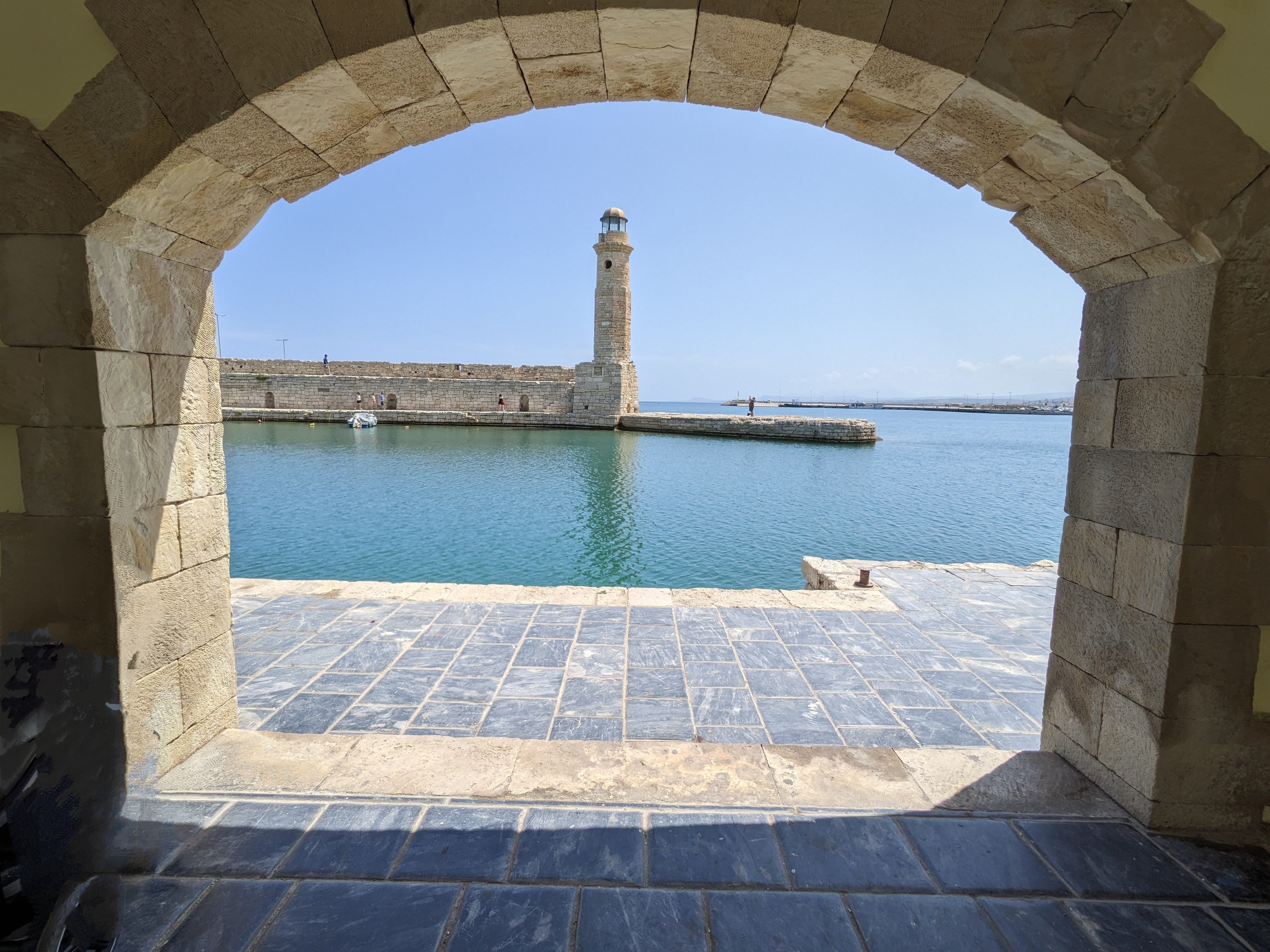
About an hour west of Heraklion is Rethymno, probably Crete’s second city. It, too, has a very fine Venetian port. Rethymno’s port also has a massive Venetian fort built on a bluff on the headlands.

A gate in one of the few remaining sections of Rethymno’s city walls.

About an hour west of Rethymno is Chania. We visited my brother in Chania in 1972, when he was stationed at the Navy base nearby. One of my fondest memories of that trip is the old Venetian port, where we sat drinking the night away 50 years ago. I was desperate to see the port again but, unfortunately, this is where COVID caught up to me. I was too sick to do anything but walk to the port and take this photo, after which we pulled the plug on the trip, and headed back to the airport.

With patience and OTC pharmaceuticals, we managed to pull each other through COVID, marveling each day at how much sicker we’d been the previous day. At any rate, two weeks later we were back to rude good health, and decided to proceed with a trip to Ikaria that we’d planned months in advance. Ikaria is an island in the east-central Aegean, renowned for the longevity of its inhabitants. The “secret” of their long lives is actually quite well known – a diet of predominantly vegetables and fruit, with the occasional fish and virtually no meat. A factor almost as significant, however, is their super-low-stress lifestyle. I’m pleased to report that includes a glass of wine with meals, as well as a measured pace and an indifference to clock time. We stayed in the island’s capital, Agios Kirikos, and often found ourselves in the taverna at the base of these stairs.


After Ikaria we were able to visit the southern-most part of mainland Greece, the Mani peninsula. Mani is wild and rough. It’s the place Susan’s grandfather emigrated from in 1910. These are views out our room windows.

This was the view from the terrace of our room, looking south down the west coast of Mani. That far cape is the Cavo Grosso, and it is indeed large – those cliffs rise as much as 600 feet above the sea. The cliffs are riddled with caves that pirates used as hideouts right up until Greek Independence. Ships sailing south from Kalamata, as well as western European shipping bound for Athens and points east, were fair game.

Aeropolis is the de facto “capital” of Mani. Under Ottoman rule, it was known as Tsimova but when the war of independence started, it was renamed for the ancient Greek god of war, Ares (known as Mars in Roman mythology). This the church of the Archangels, and it was from this church that the revolution started on March 17, 1821. Maniots immediately marched on the Ottoman garrison at Kalamata, overrunning it. Thus Maniots had been in the field 8 days by the official start of the war on March 25. Independence Day is celebrated on March 25 (the feast of the Ascension) in the rest of Greece but in Mani the parades, speeches, and fireworks all happen on the 17th.

Sitting with family at a cafe in Aeropolis, I couldn’t help but notice this fragment of a poem by Yiannis Ritsos written on the box for the cafe’s power meters. Ritsos is one of the great Greek poets of the 20th century. These are the first few lines of his poem, Our Country, loosely translated as :
We walked up the hill to see our country-
humble dwellings, modest fields, stones, olive trees.
Vineyards stretch down to the sea.
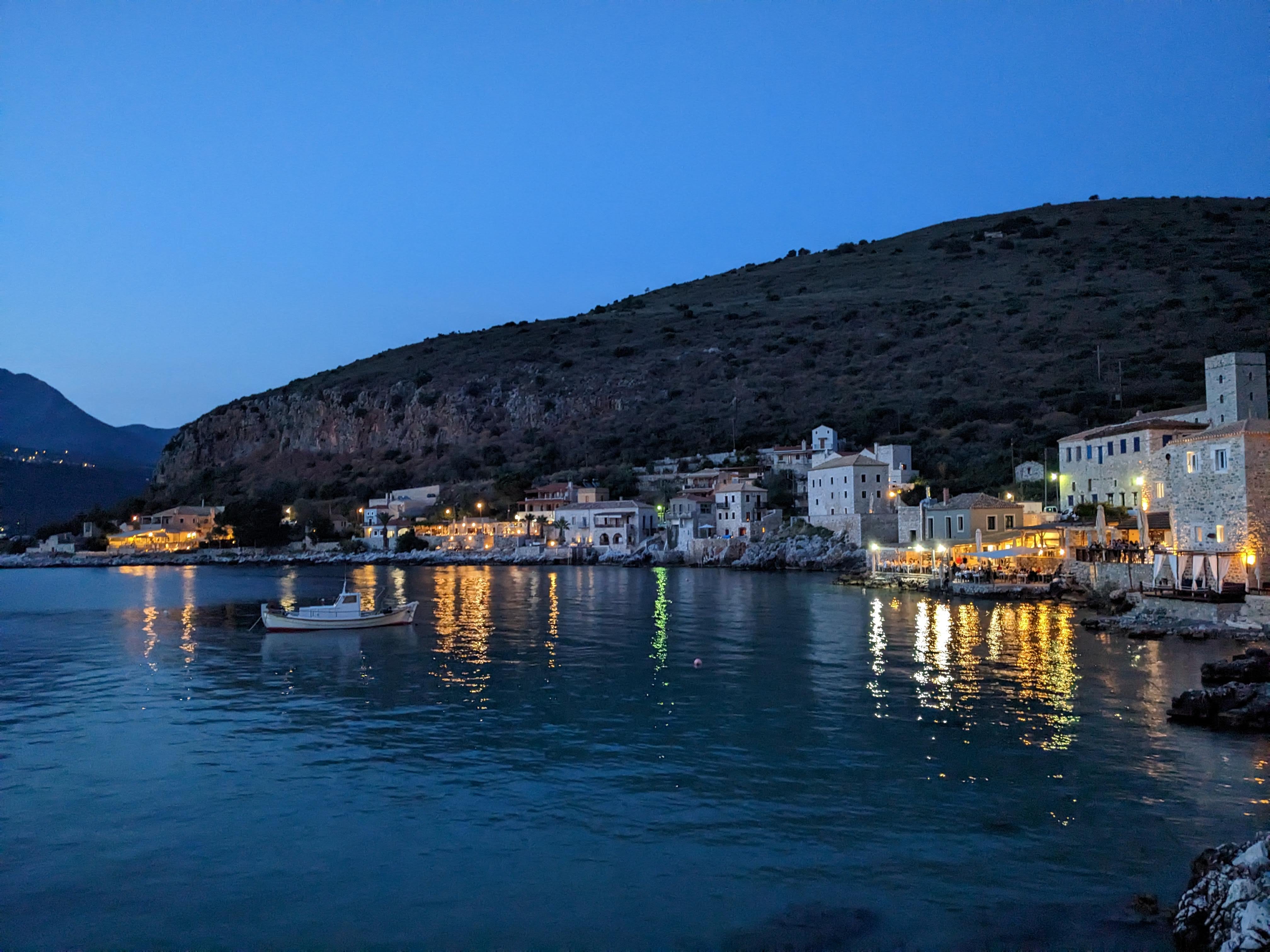
This is Limeni, the port of Aeropolis.

Sunset from Limeni.
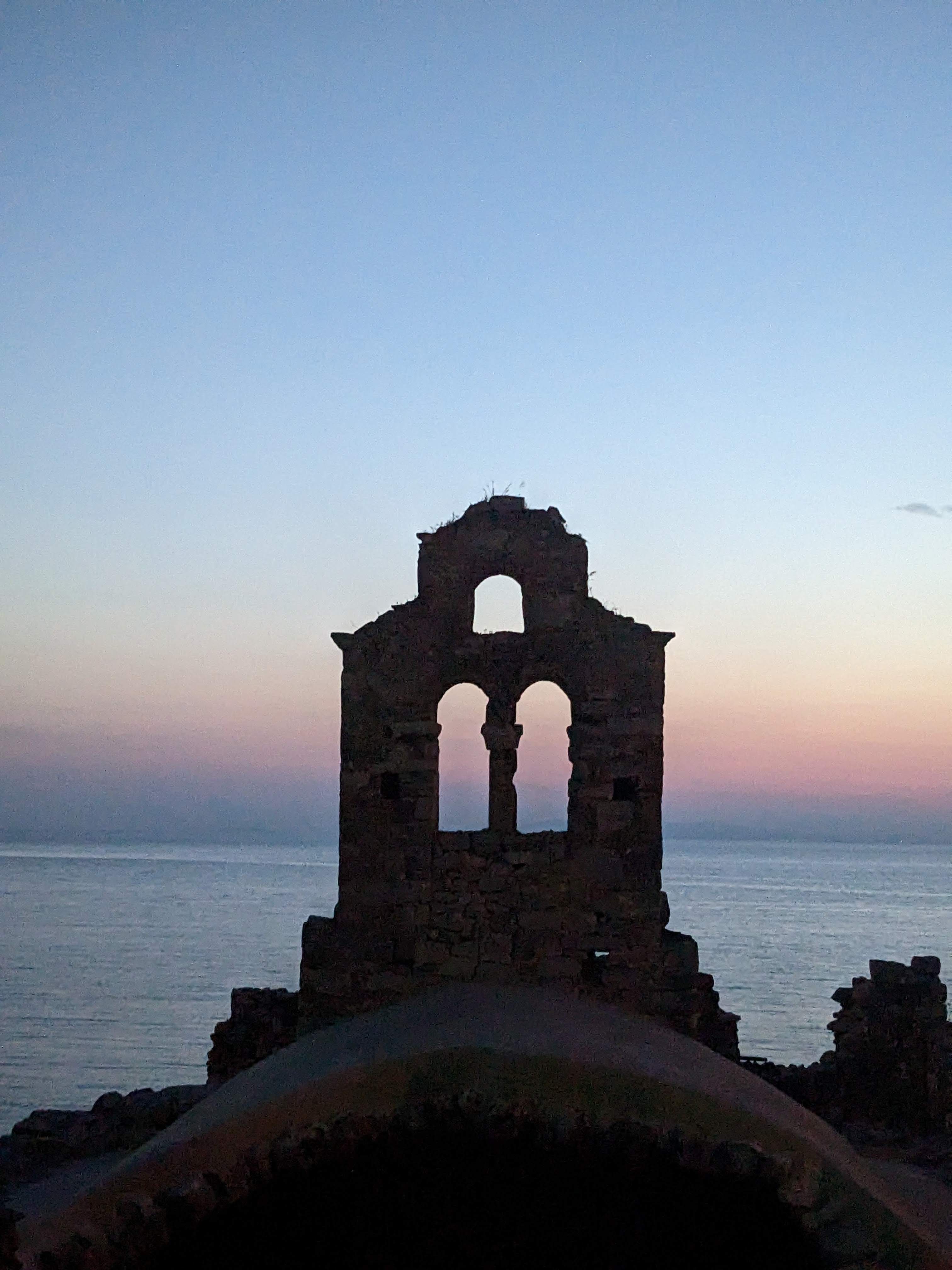
The ruins of a monastery church on the seaside in Limeni.
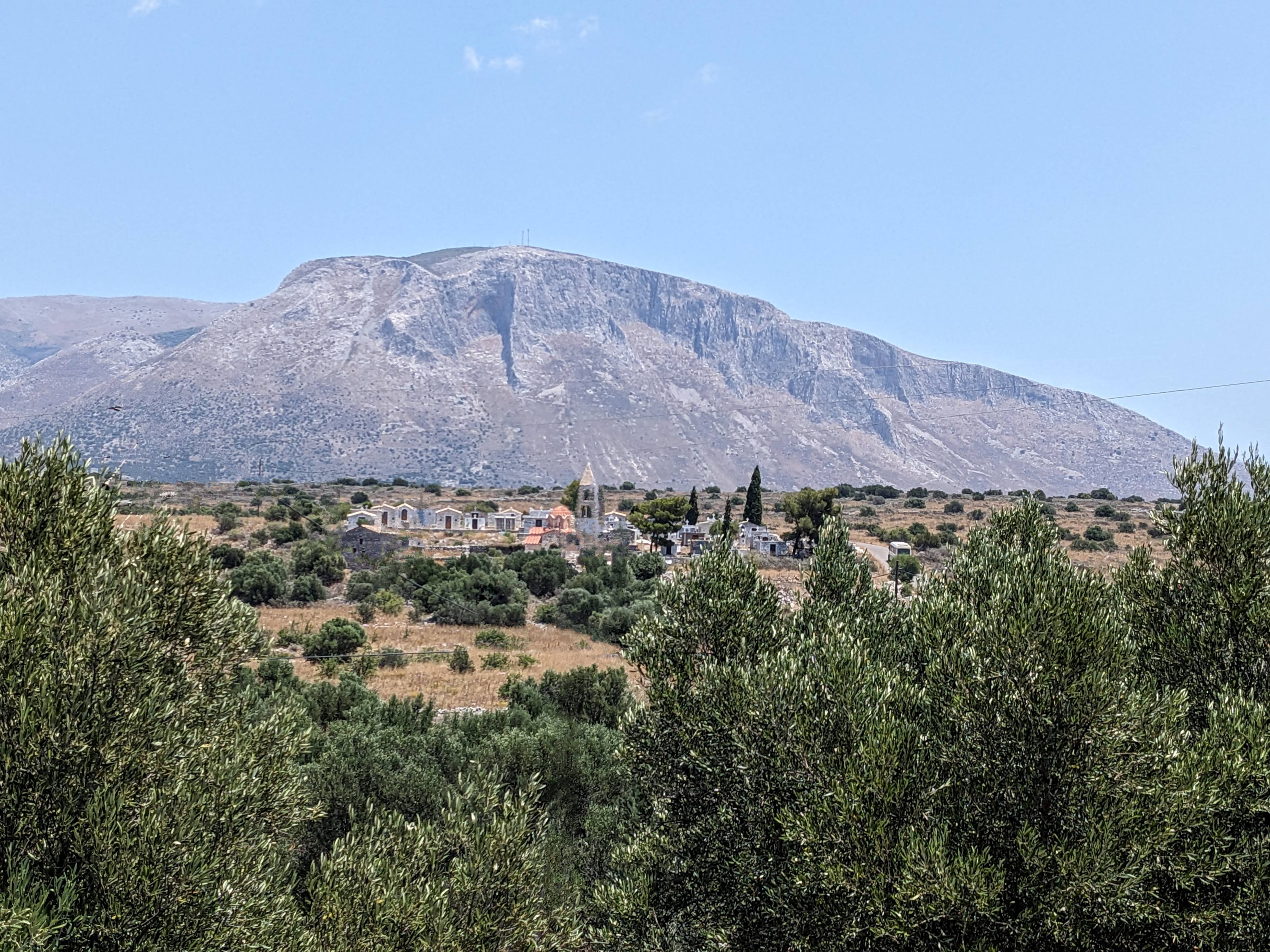
When I first spotted this church, I thought it was surrounded by the buildings of a small village. In fact it’s a cemetery, and those are mausoleums. Originally this was a monastery — all that remains is the church, and mausoleums have been built in the footprint of the monastery buildings.

Mani. The real Mani.

There are many churches in Mani. This is one of the oldest intact churches that I know. It is St. Nicholas, and dates from the 11th century. It is on the road between villages and, like most Mani churches, is always locked.

On the other side of the peninsula, however, we found a church that is left open. This is the church of Our Lady in the small village of Ochia. It’s about the same vintage as St. Nicholas, I’d guess. There are a few frescos remaining on the upper left of the iconostasis. The altar is through the opening. The bottles on the floor are filled with oil for the lamps. They may be offerings but this church is obviously being tended. It is unique in my experience because it is twinned with another still smaller and older church called St. Peter’s. The entrance is through a small opening on the left wall.

The view northeast from St. Nicholas.

Last church but this one is special for it was here that Susan’s great-grandfather was a priest. This is St. Nicholas in the small Mani village of Kounos. There are two active churches in Kounos – St. John’s has been restored, and St. Nicholas is waiting its turn. This one is remarkable for the size and number of carved stones from ancient buildings incorporated into its walls. Several can be seen in the wall on the right, as well as the lintel over the belfry door. It was from here that Susan’s grandfather left for New York in 1910.

The interior of St. Nicholas, taken through the front door window glass.

Mani is known for its stone towers with gun-slit windows. This one in the village of Dimaristika belongs to members of Susan’s family.

Abandoned houses in Dimaristika.

One of our favorite villages in Mani, Agios Kyprianos.

The full moon rising over Mani on the night of our wedding anniversary.
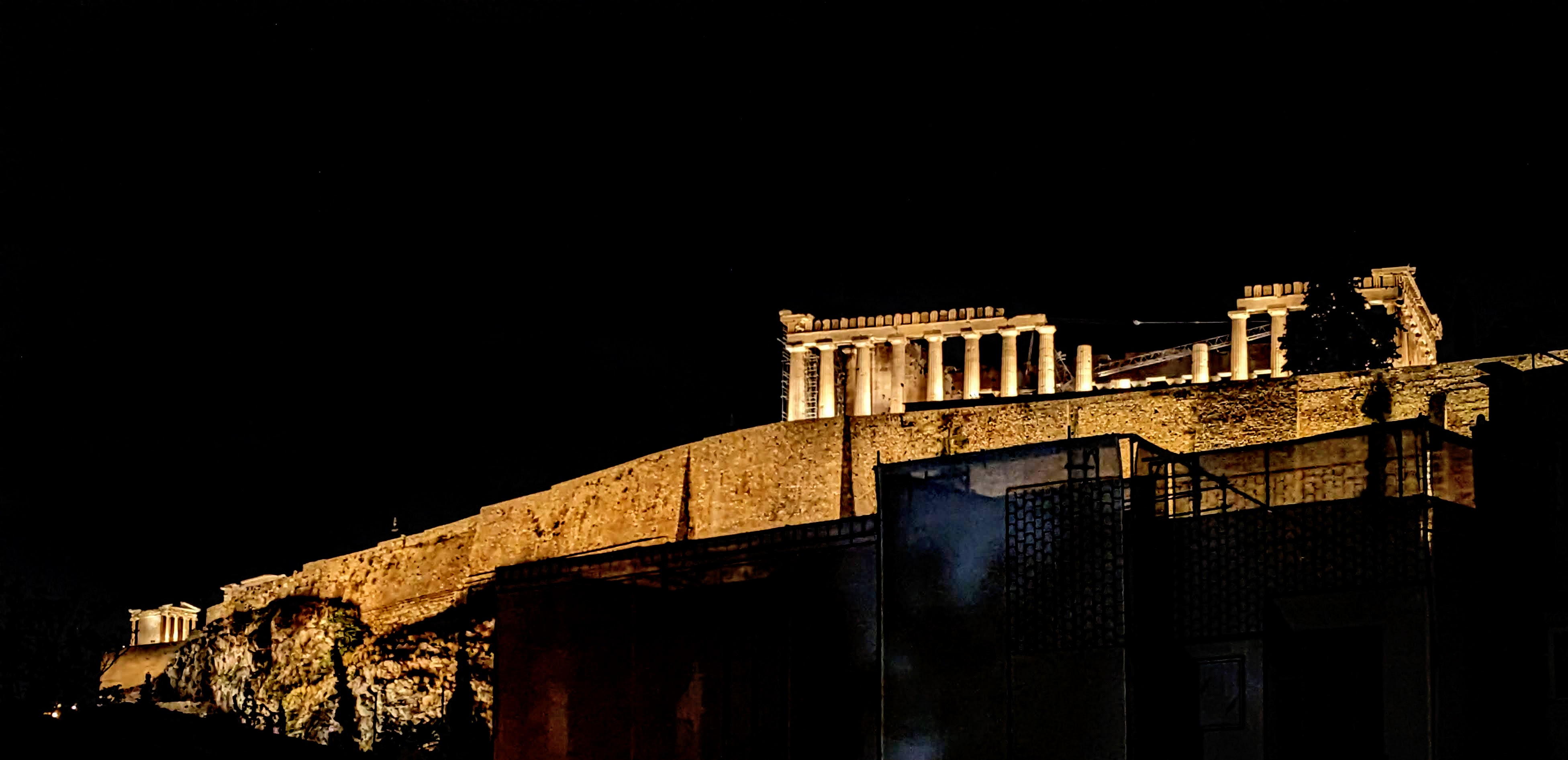
Finally, the Acropolis from the terrace of the Acropolis Museum. I’d never been on that terrace at night before. That perfect little temple of Athena Nike on the far left is one of my favorite places on the Acropolis.
As we count down the last few days of our time in Greece this year, we’re in the middle of the second week of a heatwave. The heatwaves are named like storm systems, and this one is Cleon, an Athenian general in the Peloponnesian War. In Italy the same system is named Cerberus, the three-headed dog that, in Greek mythology, guards the gates of Hades to keep the dead from escaping. (Apparently, meteorologists in Italy have a sick sense of humor.) The scorching heat and the hordes of tourists from Athens overrunning this tiny village make it easier for us to leave. The natural beauty, and the family and friends we will miss make it more difficult. I’m sure there’s a Greek philosopher with wise words about situations like this but I can’t remember them. We have plane tickets, and we’ll use them. And then, when August turns to September, we’ll start thinking about the sweet late summer days of warm afternoons and cool evenings, the mild sea waters, the pastel shading of the mountains across the Gulf, we’ll open a nice bottle of wine from just south of here, and we’ll talk about our next trip.
I’m happy to report that there have been no observable changes in Sykia during the eight months we were away. All of the tavernas and cafes survived the winter, which is reassuring. The seaside tamarisk trees got a good, and much needed, haircut at some point, and the In Memoriam notices on the power poles have accumulated in this village of mostly retirees but otherwise it’s exactly as we left it in November.
It’s a different story in the neighboring village, Xylokastro, the “big city” to our tiny hamlet. There, the transition from retail to service continues unabated. The gift shops are almost all gone, as are the boutiques, replaced mostly by cafes. Even in Greece, however, there’s a limit to the number of cafes that can be supported, and stretches of the main shopping streets are marred by strings of empty storefronts. The couple of tavernas that closed were quickly replaced by newcomers and all the others are soldiering on but it’s difficult to see how the gutted shopping areas are going to recover.
Undoubtedly, loss of income is the cause of the transition. Wages have been cut generally, taxes have been increased, new taxes created, and most importantly in these small towns of mostly old folks, pensions have been slashed each year, with yet another cut pending in the next several days. Kids are graduating and moving to Athens or abroad for work, further raising the average age of the population out here in the sticks. Sykia is too small to have had any actual retail, so it’s been spared the blight, and towns in agricultural areas appear largely unchanged because the income level has been relatively constant but the places that relied on Greek tourists coming into town with a little extra spending money have really suffered. Absent a dramatic change of some sort, it looks like a long road back for Xylokastro.
On the bright side, the NY Times published an excellent article about Athens the other day (Athens, Rising), in which the locals opine that maybe, just maybe, there’s a possibility that things are beginning to pick up. It’s the first time I’ve seen any public optimism in the last 9 years.
It’s been summer weather since we arrived, and on Friday school dismissed across the country. We’re now on the ramp-up to the full summer bedlam that is the August holiday. Kicking off the festivities is the European Day of Music on Thursday. Sykia is participating for the first time this year by hosting approximately 20 musical acts, ranging from classical to pop (European Day of Music). Naturally, the “Day of Music” requires 4 days to celebrate. We’re looking forward seeing how this goes. The schedule makes it sound as if some of the acts will perform on the beach but that’s hard for me to picture. The first day concludes with a concert of traditional music in the plateia directly in front of us — from 10:30 to midnight. Yes, a concert in the middle of a residential area beginning at 10:30pm. Kansas, it’s not.
After the madness of moving it’s especially sweet to be back here, watching the wind sweep the water. We’ve got a few tasks to accomplish but otherwise the plan is to appreciate each moment of these long, sweet days as slowly as possible.
We finally got some rain. Two weeks ago, on Labor Day, we were treated to light rain for several hours. It was enough that even the soil under the tree canopy got wet. It was the first rain we’d seen since May, breaking what for us seemed like a 3-month drought but is actually the normal summer weather for this part of Greece. We were ecstatic.
As is usual here the arrival of rain meant a change in the weather, and we were treated to a week of rain. That first day’s rain completely soaked into the parched, powdered soil but by the third day, water was running off into the drainage channels, carrying enormous quantities of mud and trash into the Gulf. The fourth day saw very heavy rainfall, with tragic consequences in the southern Peloponnese, where 5 people were killed in flooding.
Water running across the pavement did a great job of carrying off lots of heat, too. When it was over, summer’s back had clearly been broken and since then we’ve enjoyed highs in the mid 80s, lows in the low 70s, and breezes turning to the north/northwest.
Last week was near ideal, with the air scrubbed clear, the mountains finally emerging from behind the haze-skrim that had obscured them all of July and August, occasional whitecaps on the Gulf, and slowly (slowly) diminishing indoor temps. It was 84 inside the last week of August, and now it’s dropped to 80.
This morning, I was awakened by thunder and heavy rain, forecast for later in the day. Sitting on the balcony, we were treated to a spectacular light show, as lightening spiderwebbed across the clouds and a rainbow appeared in the west, opposite the rising sun. During a break in the action I ran out to grab the top photo, of Mt. Gerania down the Gulf.
We joke that there’s no day quite as fine as a rainy day in Greece, and today was no exception. After running our AM errands, a brilliant blue sky encouraged us to start a load of laundry, and it was 99% dry by lunch time, when light sprinkles had us run for the clotheslines in the back. In between, the mountains were crystal clear and I stopped again for a photo of Mt. Ellikon.
True to form, more rain’s coming this week, maybe even into the weekend. But it was beautiful for a sunset volta this evening. I couldn’t resist snapping the last light of day on the clouds over the Sikelianos house.
The weather cycle is coming back around to where we joined it last spring, and it’s beginning to feel as if our stay is complete.
Being here in midsummer always makes me think about Ocean City. When I was a kid, my friends and I divided ourselves into “beach people” and “mountain people,” eg, people who’d rather spend their summers at the beach v people who’d rather go to the mountains. I was a mountain person (I haven’t polled her but I suspect Suse would opt for the other team — although not as fervently as before she became BFFs with a dermatologist) but not only did I prefer heading to the hills, I couldn’t comprehend why anyone would want to go to the beach…unless it was to check out babes in bikinis. The beach is hot, sticky, sandy, uncomfortable, loud, crowded. The roads are jammed way beyond their capacity, there’s a line at every restaurant, pizza place, ice cream stand, and fry joint. There’s no place to park, and there’s always at least one moron driving back and forth with his car radio so loud it’s obnoxious two blocks away — and of course his taste in music is always execrable. Sand gets tracked back to the car, back to the room, into the shower. It’s in your hair and in your teeth. Sandwiches are gritty with it, towels and blankets are caked with it. Lather up with sunscreen and in seconds you’re wearing a sand veneer. It makes you (me) itchy at the same time you’re sweaty. And you’re sweaty. Because being on the beach is like sitting too close to a sunlamp the size of a bus, and someone’s opened the door of the world’s largest oven. You can see the heat haze rising from the sand — even if it’s just thin strips of sand between the checkerboard of towels and blankets. You sweat every moment you’re not in A/C or the water. And then you look over at your pals and say, “It just doesn’t get any better than this.” And yet maybe the most incomprehensible part of it all is that people sit in 50-mile traffic jams week in and week out to get there and back home.
Obviously, I’m the oddball here. Zillions of people like that stuff — you can’t find a room anywhere near the beach this time of year. People not only do this it, they actually spend a lot of the year planning to do it. It’s a reward for working all year. (Work that apparently involves rolling a boulder uphill.) So overwhelming is the evidence that I’m forced to conclude maybe even most people are on the beach side of the fence. But so long as I didn’t have to be there, I’ve never cared why everyone does. Until I’m brought right up against it, face to face.
Which brings me to Sykia. In midsummer.
When we bought here, we bought in a pretty little village stretched out along a gorgeous body of water. Population: 231. A park, a church, a few tavernas, and that’s all. As absurd as it sounds sitting here now, it never occurred to me that this place would be Ocean City for hoards of Athenians, that its population would swell ten-fold (at least), that parking would be impossible, that the idiot with the loud car radio and bad taste would follow me here, that the tavernas would be full to — and beyond — capacity every night, that sentient human beings would sling themselves out under umbrellas on the beach all day every day, that crossing the beach road could ever approximate running across the Capital Beltway, that the park would be full of people from other villages every night until very late at night, and that people would navigate heavy traffic for 90 minutes to get here. And yet it’s happened again this year, just as it has in each of our previous years.
I haven’t been back to OC in summer since high school but now I’m face to face with this beach thing every year anyway. I still can’t figure it out. Why do people like doing this? There are some who apparently take pride in getting the darkest possible tan. There’s one guy who just likes to fish every daylight hour. There are young parents letting their kids romp in the shallows. There are people who come down to cool off, floating around in the water for 30-40 minutes before heading back up the stairs. But for each of those, there’s one reading a book, drinking an iced coffee, snoozing, jawing with the neighbors, in other words: doing things that would be much more comfortable pretty much anywhere else. So why do they do it?
I can’t go along with the mystical idea that we love the sea because the progenitors of our species crawled out of the sea millions of years ago. After all, every mammal species did the same thing, and I don’t see cats or beagles lining up to get in the water. I’m forced to conclude the drivers of this strange behavior are habit, tradition, and, yes, conformity. “What should we do for vacation this year? Why don’t we just go back to the beach?” “I’ve gone to the beach every summer since I was a kid.” “Everyone’s going to the beach.” The possibility that anyone might actually enjoy being roasted alive while simultaneously being flayed by the pitiless sun in the close company of hundreds of other roastees is simply unimaginable.
So here I am, an accidental beach person. A bear who wandered down from the mountains. My inability to understand goes way beyond language.
My coping method is to focus on the things I love about this place — the clear blue water that’s now at the ideal temperature, the gorgeous mountains across the Gulf, and the amazing light penetrating the landscape to the cellular level. And the absence of sand! No sand. The pebbles can be tough on the feet but I never have to walk on a sandy floor or — shudder — sleep in a sandy bed. And the wine, a spectrum of spectacular summer whites so nuanced and delicious that they more than make up for car interiors so hot you have to stand back when you first open a door. Yes, the wine really helps with the coping.
Each year about this time I think back to a two-week beach vacation almost 30 years ago that straddled the start of school. The difference between week one and week two could not have been more stark: week one, high stress; week two, no stress. I thought then about the few permanent residents of little coastal towns like Duck, NC — how they must feel about being invaded and displaced by the mob each summer, and how they must long for the end of summer. I’ve thought about them again each of the past 10 summers. I never imagined my empathy would be so complete.
Come on, autumn!
It’s now been a week since we arrived in Sykia, and we’ve been blessed with beautiful weather since the wheels hit the runway: about 70 every day, overnights in the low 60s, clear most days, calm to light breezes. Yesterday we got a little skoni, the atmospheric dust that rises over the Sahara and blows north and east in the Spring, and today, about 100 drops of rain. If this is the worst of it, we’re just delighted. What a change from last year, when it was cool and wet and windy the first week in April.
Usually, in the spring, the seasonal river that flows under the plateia in front of the apartment runs like liquid mud into the sea. This year, there’s a trickle of clear water running across the beach, and the sea is as clear as I can remember it at this time of year. Greece is famed for its clear waters, and on still summer days here we enjoy views to the bottom so far below it almost gives one vertigo, but this spring the clarity is remarkable. I don’t know what that might mean for the reservoir levels in August, or for fire danger that same time of year but for now, it’s just gorgeous.
We’re also happy to see a new, and popular, taverna has opened here in Sykia. My guess is that the building held a taverna years before our arrival but now it’s been fixed up, painted, renewed, and reopened as Pyrgos Sykia (Sykia Tower), a reference to the old house of the Turkish bey (ruler) under which stands. Word has it that the mezzes and tsipouro (grappa) are excellent, and we look forward to giving it our own review. There’s also a new, stylish cafe in the village in the premises of a seasonal grill house that hasn’t opened in five years. I don’t know when I’ll have the chance to “review” it but it’s doing good business now, and will likely be jammed in the summer. After years of watching stores closing, it’s great to see these fresh green shoots of hope emerging from the gloom.
The highway under construction near the house is also enjoying a renaissance, in this case a second renaissance. We left with the near certainty that the work as far as our exit would be completed by the time we came back but this is Greece, and the fiscal paroxysms of last summer halted the work for months. (And it would have finished years ago but for the original deficit cataclysm.) Happily it is now proceeding at a fantastic pace and there is at least hope that when we leave we’ll drive out on the new pavement.
Returning here each spring means rediscovering some of the little delights that fade from memory over the winter. One we’ve particularly enjoyed this year is the scent of orange blossoms. A couple of property owners here in Sykia have small stands of orange and other citrus, and passing by these trees on our walks always produces sighs and extra-deep breathing. Another special treat is the strawberry crop. Our greengrocer follows the crop from Crete in the far south to Macedonia in the far north, so we get perfectly ripe strawberries for months. They’re already incredible, and we are looking forward to this continuing until the peaches start to come in. Oh, the peaches…
One of the great pleasures of being here, though, is seeing our friends and family again. They’ve all told us that they’re doing fine, and they mean it, although it’s understood in the context of 24% unemployment and capital controls. This time, though, I’m noticing that after 7 years, the recession/depression is beginning to feel like the new normal. People expect the current catastrophe to continue indefinitely, and improve only very gradually, so they have adjusted their outlook accordingly. The attitude now is one of making the most of a bad situation. That’s a sea change from feeling crushed by macro economics, and, to my way of thinking, represents the beginning of the road to recovery. It seems clear that Greece’s future will be defined not by the IMF, the EU, and ECB, not by the politicians, the bond traders, and the talking heads but by ordinary people doing what they’ve always done; finding a way, adjusting, persevering, and adjusting again. To be sure, this does not represent the beginning of the end of the misery but, to me, it presents a possibility of a long, difficult climb out of the abyss. And that’s the most positive I’ve felt about the situation in a long time.
Anyway, it’s a poor spring that’s devoid of promise, and we’re finding hope in its greatest reservoirs — nature and the human spirit. As always, it’s great to be back.
PS: Not directly related, but if you have 6 minutes, you might enjoy this gorgeous video of the night sky of Greece, “Greek Skies.” The videographer, Panos Filippou, spent a year of nights capturing stop-motion and time-lapse video of the sky, and he’s done a great job editing and laying a music track under it. Enjoy: Vimeo Greek Skies or YouTube Greek Skies
Now fully immersed in packing and preparing to leave, we’re casting our thoughts back over the last 3 months and trying to soak in enough of all the things we’ll miss to last us until we return. It’s been an unusual season in Greece for us: our earliest-ever arrival and our earliest-ever departure. And, while our neighbors and relatives assure us it was an unusually long and wet winter, it’s not a schedule we’re likely to repeat.
Winter here is nothing either of us can complain about but we saw enough to understand what the locals dislike about it. Cool, wet, and windy conditions when you’re longing to be outside is annoying. Leaving the ridiculous weather Washington had this February, we were overjoyed to find the precipitation was liquid rather than frozen. The temperature in the unheated apartment when we arrived was 62. With overnight temps dropping only to the low 40s, we were more than willing to put on jackets to down our morning pot of tea on the balcony. But 4 of the 6 weeks before Easter were wet. We had to postpone our trip to Mani until the third week just because we wanted to explore it without raincoats. And dining al fresco was problematic because anything hot cooled before even we could wolf it down.
The six weeks since Easter have been almost idyllic, though. Perfect springtime temps with highs in the 70s, puffy clouds, and mostly gentle breezes. We’ve had few short showers, a few days of strong winds, and the normal occurrences of Saharan dust blown north by high-altitude winds. But since Easter we’ve turned off the heat, opened the windows, and most days we ate three meals outside. Appreciated a few bottles of wine out there, too
In my first post this year, when I said nothing had changed in Sykia, I forgot to make note of the significant tree cutting and replanting work that had been done on the Sykia side of the Pefkias (Pine Forest) that is the pride of the neighborhood. A lot of activity there has helped diversify the forest, reduce fire danger, and improve the health of the established trees. I also neglected to mention work on the Sykia portion of the new highway. The bridge over the stream that runs near our apartment has been finished, and the over/underpass where the new highway crosses the railroad has also been completed, although the approaches to it have yet to be started. We are full of hope for what we might find when we return next year.
It’s been a difficult season for the economy, which has slipped back into recession, and has suffered four months of uncertainty about the future. We’ve swung between optimism and despair with the winds of the rumor mill but we are currently hopeful that a long-term agreement will be reached this summer, and that that agreement will put the country on the road to a lasting recovery.
This year we noticed for the first time that orange trees flower while still holding ripe fruit. While great citrus is crazy-abundant here, we also enjoyed excellent strawberries for virtually the entire three months…and they’re not fading yet. We noted the progress of the tomato crop almost from day-to-day, and are savoring near-perfect flavor and aroma right now from a local crop. Korinthia is famous in Greece for its table grapes and raisins and, while we missed the grape harvest, we took full advantage of the raisins; consequently, we are unlikely to ever open another box of Dole’s.
We could put up a catalog of small discoveries and big memories from this year’s trip. I particularly remember visiting the astonishing church of a long-gone monastery on the mountain high above Mariolota, and realizing that we could see our breath inside. Outside, the temps were probably in the 60s but the thick stone walls held winter’s freeze tight, and I got a new appreciation for the monks who once rose before dawn to chant and pray in that beautiful ice-box. We were also shown the lovely Flisvos Marina near Athens, and then amazed by the maritime museum it contains – imagine a full-scale trireme, with oars extended!
After years of noting the loss of one shop after another, this year we took particular pleasure in seeing a host of businesses that, rather than shut down, chose to up their game. New paint, new decor, new tables and chairs, new menus, new spirit, new attitude go a long way to reassuring everyone here that it is possible to make a go of it, even now. The tourists like the fresh look, and the locals like it even more.
So we leave feeling good about the prospects for our village, and for Greece. We wish our family and friends here a good summer, Kalo Kalokairi, and look forward to seeing them, and the mountains across the water, when we return again to this magical land.
My first State of the Vines post goes back to March 12, two months ago. I’d intended to update it sooner. I’ve been glancing at the vineyards as we drove by but haven’t had the chance to stop for a photo without trespassing, which I’m not inclined to do.
We had the opportunity to visit the G’aia winery in Koutsi on Saturday, May 9. It was especially delightful because it is prominent in the tiny pantheon of our very favorite wineries, and because, as far as we know, it is only open to visitors twice a year – once in the Fall for the Great Days of Nemea festival, and once in the Spring for an event called Open Cellars that includes wineries across Greece. G’aia’s official tasting room is at its winery on Santorini, and is one of the island’s highlights.
The first State of the Vines photo is from a vineyard on the flatlands, close to sea level. This vineyard is in the mountains, at an elevation of 1800 ft., so it’s probably a couple of weeks behind the lower vineyard. Nonetheless, the shoots are a couple of feet long, and the vines are covered in leaves, many of them full-size. The weather finally turned spring-like about a month ago and when that happened we noticed the shoots start, and then jump from day to day.
I won’t be able to post additional State of the Vines updates this year but I hope to pick it up again next year with at least two more updates from later in the season.
Tasting notes: The 2012 G’aia Estate has just been bottled, and it holds the promise of a legendary wine. It has the finest, most symmetric structure I’ve ever experienced. And it’s beautifully proportioned – big and satisfying without being overpowering. Achingly, it’s going to take a lot of patience to get the best from this wine. I’m going to try to resist opening a bottle for two years, and I expect it taste young even then. Opening way in advance is going to be the only way to handle this one. Good thing there’s a lot of other wine to keep us busy ’til then.
Sika means figs in English, and I’m posting this photo of some sika growing nearby because our village, Sykia (or Sikia or Sikya) means fig tree. In the age of sail, seaside villages often took their names from some distinguishing feature of interest to mariners. Fresh water was always a concern, so there are villages called good water, lots of water, dry, etc. Navigation was an equal concern, and being able to locate one’s place on the map required landmarks, so other villages are named for whatever was most visible from the sea — the next village is called Xylokastro for its wooden castle or single castle. I doubt anyone out in the Gulf could spot a fig tree on the shore, so I assume our name promised that, at a minimum, figs could be had here. The village just east of us, Mellissi, would advertise the availability of honey. During the Ottoman occupation, the local Ottoman chieftan (bey) built a large house on the highest point of our village shore. The house included a tower, possibly a minaret, and so the village was renamed Pyrgos (tower). The tower was toppled when independence was won, and the name reverted to Sykia.
I’ve learned that our village also has some ancient history, which isn’t too surprising in this part of Greece but all I know is that villagers digging in their gardens have found ancient artifacts. One of the most surprising things I’ve learned recently is that, into the Ottoman era, the sea extended right through the middle of the present village, almost back to Geliniatika, the village adjoining Sykia to the south. This revelation suddenly made sense of some landforms in the village that seemed odd but had not inspired any critical thought. It appears that sediments washing down from the hills above gradually silted in the anchorage, which would have included the site our apartment, and that the Old National Road, running along the beach, serves as a dike to keep the sea from reclaiming the land.
I’ve just learned most of this detail about our part-time home from Sykia’s delightful and surprising website, Sykia.gr. Well designed, interesting, and useful, the site includes an excellent, full English translation and some very nice photography.
The website notes that, by legend, the fig tree for which the village was named stood on the hill by the bey’s house. There’s now a taverna at the foot of that hill called The Courtyard of the Bey, and I find myself walking the village trying to imagine the outline of the harbor, boats moored out in its center, travelers sitting at tables under the trees, and sailors carrying casks and crates down to a pier. It’s a new dimension of Sykia for me, and it comes thanks to the efforts of some of my approximately 600 neighbors to tell the story of this place. We’re beginning to feel as if we’re a part of this sweet village.